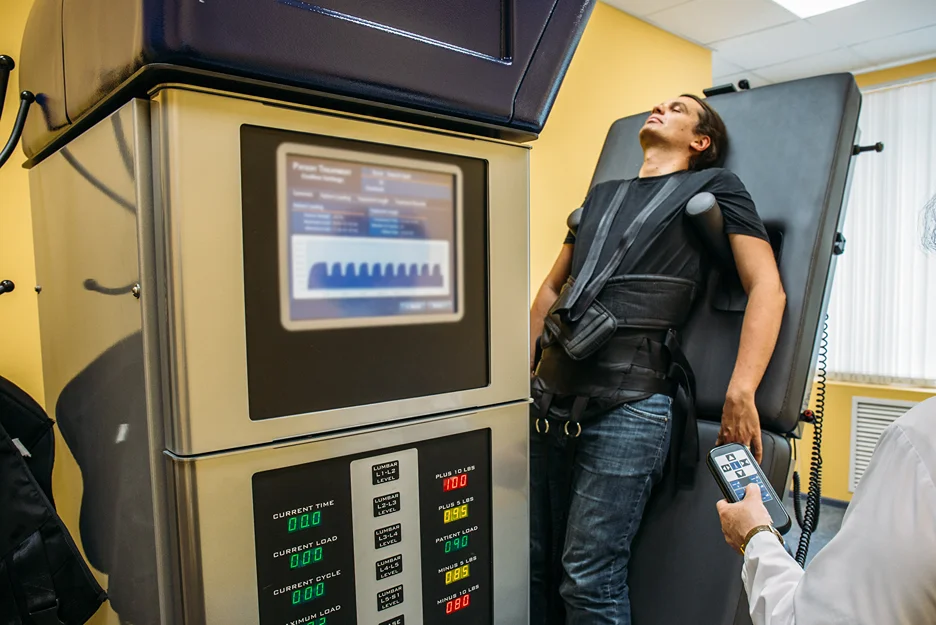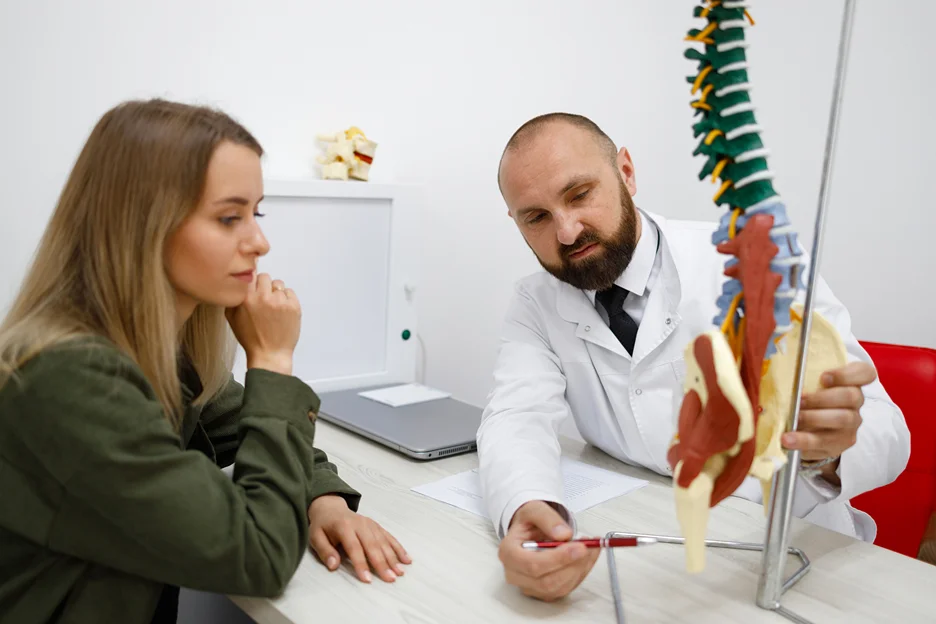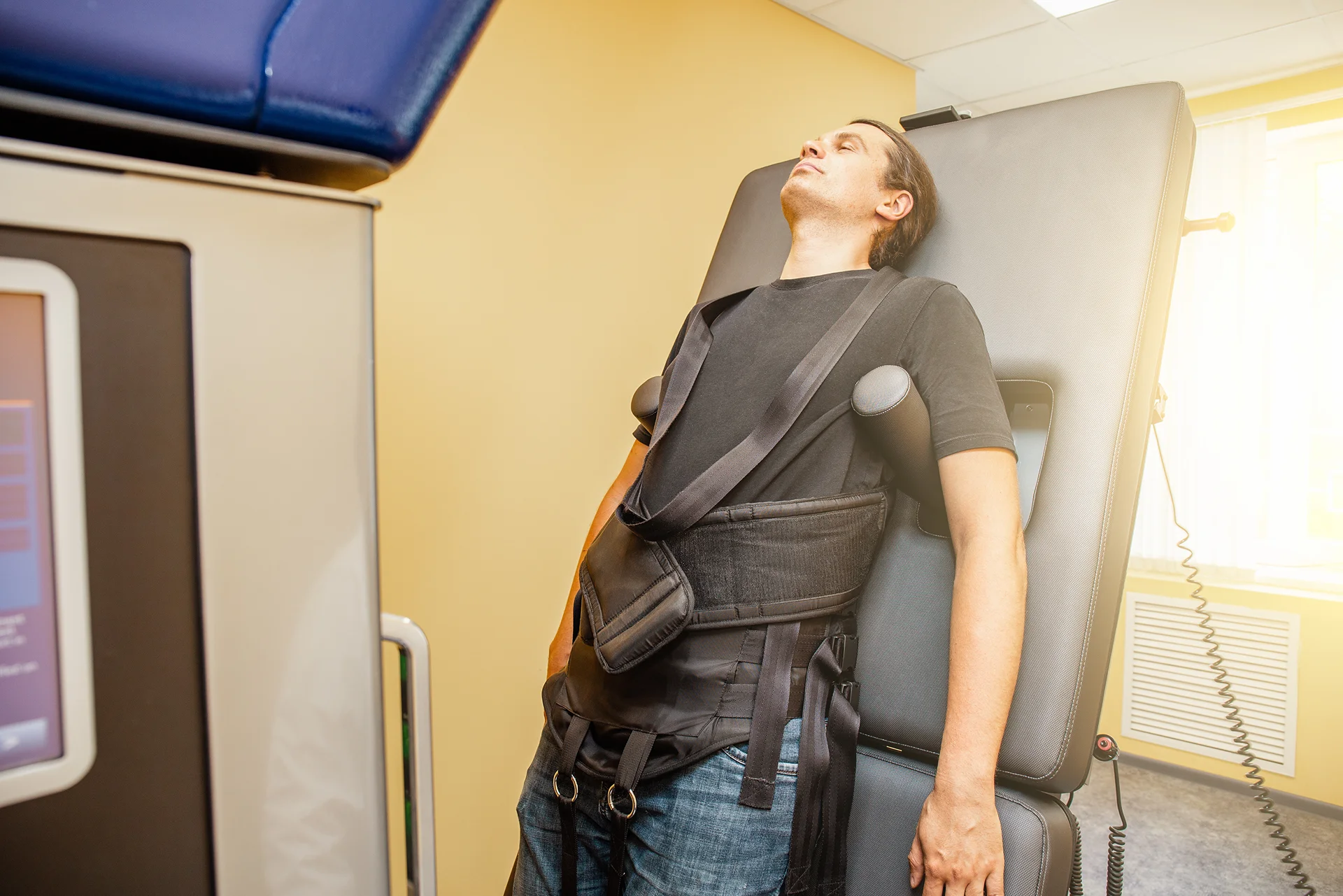Discover how expert-guided decompression therapy can gently relieve the nagging leg pain of sciatica – without drugs or surgery.
For those afflicted with sciatic nerve pain, daily life can feel like an uphill battle. The searing pangs that travel from the lower spine into the legs make once-simple tasks seem insurmountable.
We at Kaly recognize the hardships caused by this troublesome condition all too vividly. Our aim is to equip sciatica sufferers with information on decompression therapy, a promising solution for alleviating compression on the sciatic nerve roots and mitigating symptoms.
With knowledge and perseverance, we believe those beset by sciatic nerve pain can regain functioning and take back their lives.
What is decompression for sciatica, and how does it work?

Decompression therapy is a non-surgical, drug-free treatment option that can provide relief from sciatica pain caused by a herniated or bulging disc pressing on the sciatic nerve. It works by gently stretching the spine to take pressure off the compressed nerve root(s) contributing to your sciatica symptoms.
During decompression, you lie on a specialized table that slowly and gradually pulls your spine apart to gently create more space between each vertebrae. This helps create negative pressure within the disc, allowing any herniations to be drawn back inwards, taking pressure off the irritated nerves.
Think of it like releasing pressure from an over-inflated balloon. As the pressure decreases, the balloon returns to its normal size and shape. The same concept applies to decompressing bulging discs.
Which specific nerves, when compressed, can lead to sciatica, and how is decompression applied?
Sciatica most commonly occurs when the L4, L5, or S1 nerve roots become compressed or irritated as they exit the lumbar spine. The sciatic nerve runs from these roots down through the buttocks and legs. Decompression therapy targets the lumbar region where these nerve roots are located by gently mobilizing this section of the spine through calibrated spinal traction.
How does a herniated disc contribute to sciatica, and can decompression therapy help?
When a disc herniates and the inner gel pushes outwards, it can impinge on nearby nerve roots, leading to inflammation and sciatic pain.
Decompression helps pull the herniation back in while decreasing internal disc pressure to allow healing. This alleviates compression on the nerve root(s) causing your sciatica symptoms.
Clinical studies have shown decompression therapy can help reduce herniated disc size and leg pain and improve mobility for patients with herniated discs.
What are the best stretches to alleviate sciatica pain?
Certain stretches can assist in decompressing the sciatic nerve to find relief from shooting or burning leg pain. Here are two of our top recommendations:
| Stretch | Instructions |
| Piriformis Stretch | Lying on your back, cross your affected leg over the other and grab behind the thigh of your bent leg.Gently pull towards your chest until you feel a stretch in your buttocks.Hold for 30 seconds. Repeat 2-3 times per side. |
| Figure Four Stretch | Lying on your back, cross your affected leg over so your ankle rests on the opposite thigh in a “4” shape.Clasp your hands behind the uncrossed thigh and gently pull it towards you to feel a stretch in your glutes.Hold for 30 seconds, repeat 2-3 times per side. |
| Child’s Pose | Kneel on all fours. Slowly sit your hips back towards your heels as you lower your chest between your knees, reaching your arms forward. Feel the stretch along your sciatic nerve through your back and legs. Hold for 30 seconds, repeat 5 times. |
Perform these daily to keep your piriformis and glutes from getting too tight and putting pressure on the sciatic nerve.
How does chiropractic care help in the treatment of sciatica?

Chiropractors use spinal adjustments to improve mobility and alignment of vertebrae in the lumbar spine to take pressure off compressed nerve roots. Though not a decompression technique, research shows chiropractic can be beneficial for sciatica when combined with nerve mobilization stretches and exercises.
What non-invasive treatments are recommended for managing sciatica pain?
Along with decompression therapy, people can opt for these sciatica pain management techniques:
- Heat or cold therapy – Use heating pads or ice packs to reduce inflammation and relieve sciatic nerve pain. Alternate heat and cold for best results.
- Medications – Over-the-counter anti-inflammatories (like NSAIDS) or analgesics can temporarily relieve pain.
- Acupuncture – Fine needles placed along the sciatic nerve pathway can block pain signals. Reduce inflammation and provide pain relief.
- Massage therapy – Gentle soft tissue techniques applied along the piriformis muscle and down the leg can relieve sciatic tension and spasms.
- TENS therapy – Mild electrical nerve stimulation helps modify pain signal transmission to the brain to reduce sciatica symptoms.
When should someone consider surgery for sciatica relief?
For most sciatica patients, conservative treatments should be trialed for 6-8 weeks before considering surgery. Surgical intervention may be recommended if you experience:
- Leg weakness making walking difficult
- Loss of bowel or bladder function
- Progression of herniated disc size pressing on nerves
- No improvement with non-surgical sciatica treatments
- Persistent and severe leg pain impacting quality of life
Talk to your doctor about the risks and benefits of surgery if your symptoms are not adequately controlled with more conservative therapies.
What are the primary benefits of undergoing spinal decompression surgery for chronic sciatica?
For patients who have exhausted non-surgical options without relief from chronic sciatic pain, spinal decompression surgery may offer:
- Direct decompression of the compressed nerve root(s) contributing to sciatica
- Significant reduction in leg pain severity and frequency
- Improved mobility and ability to remain active with less pain
- Decreased need for pain medication long-term
- Reduced inflammation and nerve irritation
- Prevention of further disc herniation or nerve damage
- Better quality of life and ability to resume normal daily activities
Keep in mind surgery does come with risks like infection, blood clots, nerve damage, and relapse of disc herniation. Thoroughly discuss the pros and cons with your neurosurgeon.
Kaly Can Help You Manage Sciatica

Our experts here at Kaly hope that this overview has helped you better understand how decompression works to liberate compressed sciatic nerves and provide a path to recovery.
Don’t let sciatica keep you sidelined. Get in touch today to discuss how decompression may be able to help you finally find relief!
